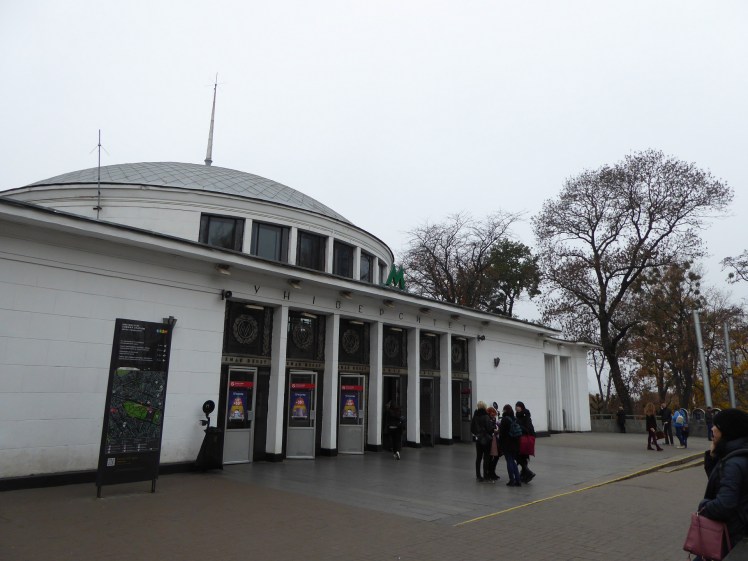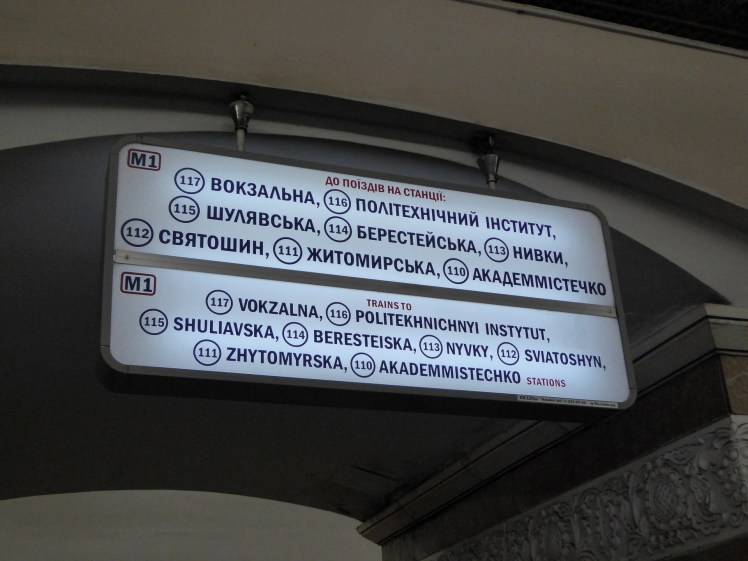Last week I went to Ukraine and while I tried to read & be prepared, there was still plenty that threw me. So here is my Beginner’s Guide to Ukraine.
Arrival – paperwork
I knew that as a UK resident, I didn’t need a visa but then I arrived at the airport and found a pile of landing cards. I was pretty sure I didn’t need to fill one in – but only pretty sure. I’ve never been required to fill in any paperwork to enter any country but the small print – in English – at the bottom of the card said it needed to be filled in by “foreigners”. In Ukraine, I’m a foreigner. But the only people filling in this form were the ones who had clearly walked straight over to the table to pick up the form in question. No one had noticed it, picked it up, read it carefully, looked around uncertainly and then filled it in.
No, I didn’t need to fill it in. As an EU passport-holder, I needed no visa and at passport control, the border guard enquired “London? Ukrainian International Airlines?” and when I said yes to both, he stamped my passport & I walked out into Ukrainian territory.
Kyiv Boryspil airport
Boryspil airport is totally bilingual, Ukrainian and English, no worries if you don’t read any Cyrillic. I assume that’s going to be the same at other airports in Kyiv and probably the rest of Ukraine.
When you emerge from the secure Arrivals area into the big room where people wait for their arrivals, there are a few things you might want. First, right in front of you, there are automated machines that you feed Euro notes into and get UAH notes back. If you prefer a human being or you don’t have Euros, turn to your left and find the exchange kiosks. If you want to skip the exchange step and just take money out of an ATM, that’s also to your left, at the bottom of the escalators. The machines have a “select English” button nice and prominently. Word of warning: you can only take out the amounts the machine offers; you can’t enter your own random value. Maximum is 1,000 UAH (today that’s about £27 / €31 / $35) and if you want more, you’re going to have to go through the entire process again. It gave me a good mixture of notes, from 200UAH right down to 20UAH.
Do you want to go into Kyiv? Outside, turn right and find the signs to city bus and get on the Skybus or the 322, which are the same bus. The Skybus website will show you a very bright pink branded bus. In real life, it’s just as likely to be an ordinary bus with no Skybus branding or labelling at all. It’s fine. It costs 100 UAH (£2.70 / €3.11 / $3.55) one way to the south terminal at the Central Station or 60 UAH to the nearest metro station at Kharkivska.
My guidebook recommends not getting a taxi. If public transport isn’t your thing, for whatever reason, use Uber.
Arrival in central Kyiv
When you arrive at the Central Station, you’ll probably want to start by going into the metro. The Skybus will drop you off outside the south terminal – there’s a big white building with columns and a lot of people pouring out. Go inside, go up the escalator and walk straight across. The tracks are beneath your feet and people waiting for trains wait in the passageway rather than on the platform, so it’s going to be pretty busy. When you get to the far end and re-emerge into the fresh air, turn to your left. There’s a round building with columns and you should see a bright green M on it. Any building with a green M contains an entrance to the metro. This particular one is a Red line station called Vokzalna.

How to use the metro
As of November 2018, a single journey on the metro costs 8UAH. There are contactless cards available but I haven’t figured them out. Tokens are easiest.
You can buy tokens in two places. You can go up to the window and hand over some cash and the lady inside (I never saw a man) will give you a green-blue plastic token and some change. There’s no need to speak a word, although a “dyakyu” (thank you) wouldn’t be a bad idea. If the lady speaks to you, you’ve probably given her enough cash for multiple tokens and she is asking how many you want. Hold up the right number of fingers. Often she will assume you’re only after one or will only sell you one at a time. You don’t need to worry about giving too much cash for one little token – at my very first trip, the girl in front of me handed over a 200UAH note and got a lot of change.
If you have a 10UAH note, you can use the machines. They’re orange, they’re on the wall and you can’t miss them. There’s a slot to insert the money and when the LEDs along its edges flash green, it’s ok to put the money in. It will spit out a token and a 2UAH coin. Save up four of these and you can hand them to the lady behind the window. Oddly, if you go to the window with a 10, you’ll get your 2 change as a note rather than a coin. Coins only come from the machine.
At the barrier, put your token in the slot and walk through. The barriers will already be open but don’t be fooled – there are sensors that detect if someone hasn’t put in a token or scanned a card, those barriers will slam closed.
At the bottom of an escalator – or two – you’ll find a tube-shaped tunnel. Trains going one way are through the columns to the left of this central tunnel and trains going the other way are on the other side. Which way is which depends on which station you’re at and which entrance you came in. How to tell which side to go to? There are signs hanging above them listing the stations the train will stop at. They’re listed in Ukrainian Cyrillic and in the Latin letters we use in English, so all you need is to know the name of the station you’re heading for in one alphabet or the other.

There are no barriers when you leave the metro.
Kyiv has three metro lines and in a few places they overlap. For example, I took the Red line to Kreshchatyk and that is linked to the Blue line at Maidan Nezalezhnosti. They’re two separate stations but they’re joined underground by a couple of tunnels and because you don’t emerge into the fresh air, you don’t need to pay again. It’s exactly like what happens in London except the different lines are considered different parts of the same station and in Kyiv they’re considered different stations.
Crossing the road
I don’t know if jaywalking is a thing but I didn’t see anyone crossing the road anywhere except at proper crossings. More often, you go down stairs and through an underpass. And these are mostly not just underpasses, these are underground shopping centres. The one under Kreshchatyk stretches all the way under Maiden Nezalezhnosti; it’s the biggest, newest, shiniest and “most Western” shopping centre I stumbled on and it’s got a Billa supermarket at each end.
Street entertainment
In a lot of places, you might find you’re approached by someone carrying an armful of white doves. I don’t know if they’re a scam but I was wary – I let my person stop, chat & introduce the doves and next thing I knew, one was perched on my hand and one on my shoulder and their owner was trying to convince me to have my photo taken with them. I don’t know what the cost for this would have been, if any, but I handed the doves back and fled. The men carrying monkeys in children’s clothes I gave a very wide berth.
Cyrillic/Ukrainian/Russian
Broadly, most people speak Ukrainian & Russian. The only people you’re likely to find speaking English are mid-20s and below. A lot of the things you’ll need will be signposted in Ukrainian and English, or if not English then Latin letters at least. You don’t need to be able to decipher Cyrillic, although I found it very interesting to try. There are maps on a lot of street corners, labelled in Ukrainian on one side and English on the other. The metro and the main station are bilingual. Buying tickets for entry into assorted churches have bilingual notices but there’s not so much English in the lady behind the window. She knows what you want, though, especially if you give her more or less the right cash.
Cash or card?
Unless you’re using a machine I didn’t go near or have a contactless card, the metro is cash only. Buses look cash only and I’m pretty sure the Skybus is cash only. Shops and hotels, on the other hand, take cards.
Political situation
In 2013-2014, Ukraine had a full-on revolution in Maidan Nezalezhnosti called Eurmaidan or the Revolution of Dignity. Half the square and most of the streets leading down to it are a mix of improvised and official memorials to the hundreds of people killed. Just keep it in mind.
Russia is currently occupying the Crimean peninsula. This is not recognised by pretty much any country except Russia. It’s difficult to get there from Ukraine at the moment and Ukraine considers going there from its territory illegal entry. It’s easy to get there from Russia and legal from the Russian point of view but again, considered illegal by pretty much everyone else. Again, keep it in mind.
A large chunk of eastern Ukraine is also occupied. My guidebook’s advice is “don’t even try to go there.”
So, while most Ukrainians still speak Russian from the Soviet days, the two countries are not best friends at the moment. Yet again, just keep it in mind.
That doesn’t even nearly cover a trip to Kyiv but I think it covers most of the basics I wish I’d known. If you have any questions, leave a comment below & I’ll do my best to answer.